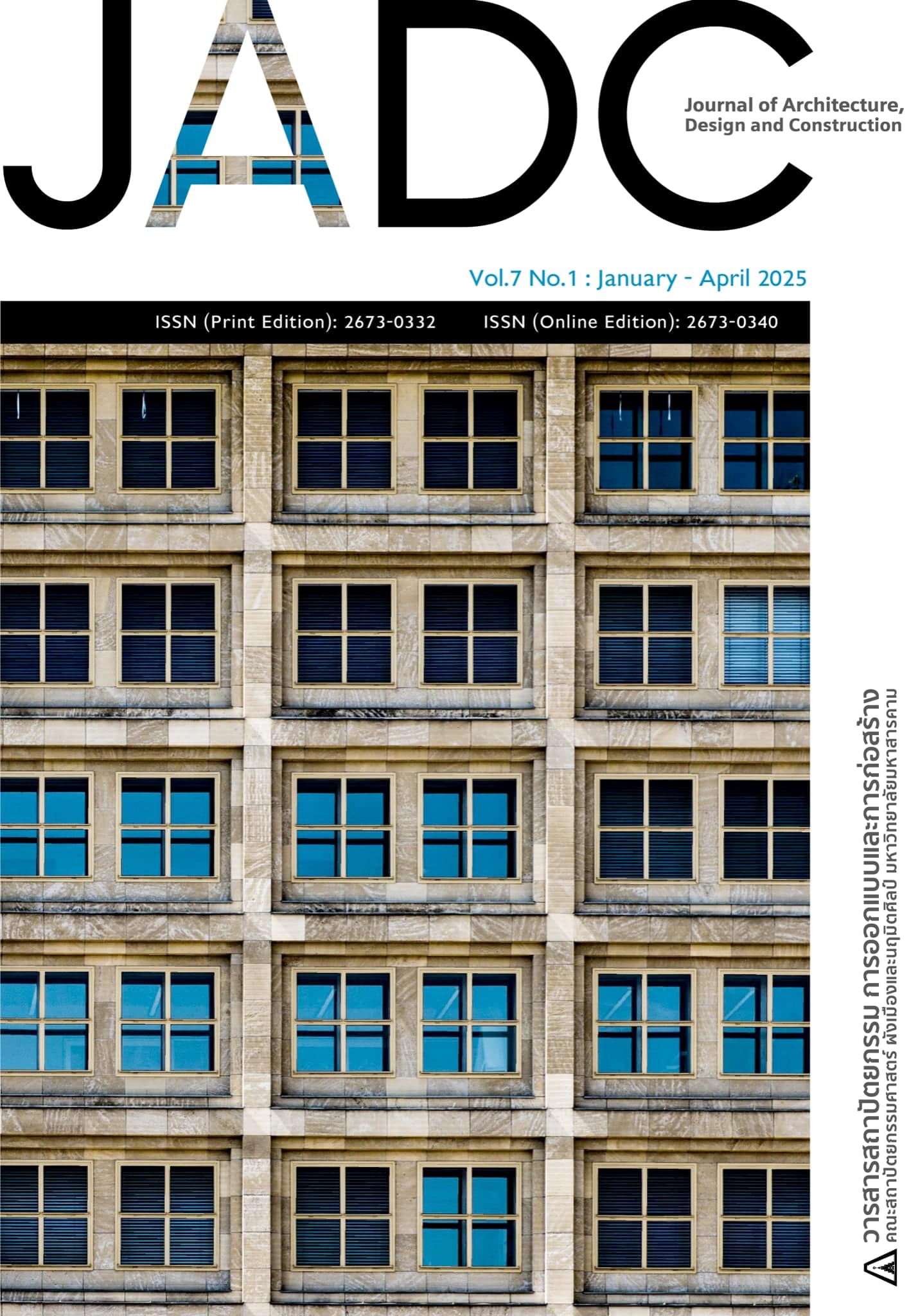Exploring Youth Perception through Architectural Graphic of Modern Facade Analysis in Chiang Mai
Main Article Content
Abstract
This research article focuses on studying the perception of modern architecture in Chiang Mai city among Chiang Mai's youth. The aim is to develop an infographic to provide information on modern architecture in Chiang Mai, serving as a future educational guide for the youth. The study targeted a sample group of Chiang Mai youth aged 16–18, a developmental stage at which individuals can analyze and respond to complex issues, serving as a key dependent variable in this study. The study examined their perception of modern architecture in Chiang Mai through the analysis of graphic representations of architectural facades. The research employed a method of transforming photographs of modern architectural facades into graphic images using Gestalt Theory. This transformation converted the buildings into graphic representations, where the graphic facades served as an independent variable capable of simplifying visual perception by eliminating unnecessary details, leaving only the key architectural elements that influence the perception of modern architecture in Chiang Mai. The study employed a survey method with youth participants using questionnaires and in-depth interviews, which included: 1) a survey on the perception of architectural facade elements. 2) a survey on youth experiences with modern architectural facades in Chiang Mai. 3) in-depth interviews and focus group discussions to explore the values and deeper experiences associated with modern architecture. The study found that the most recognizable architectural characteristic for youth was repetition, while symmetry and distinctiveness were the least perceived. Youth primarily observed architectural elements through the overall mass of buildings, with repetition being the most apparent feature in modern architecture in Chiang Mai. Their perception plays a crucial role in shaping the meaning and significance of modern architecture in the city. Understanding how young people perceive and experience these buildings contributes to an awareness of their presence and historical value. The study also highlights how personal experiences whether direct interaction or mere exposure affect the recognition and appreciation of modern architecture. These studies provide an understanding of the significance of buildings from the perspective of modern youth and their opinions on architectural conservation. The findings will lead to recommendations for youth, making information about modern architecture in Chiang Mai more accessible for learning.
Downloads
Article Details

This work is licensed under a Creative Commons Attribution-NonCommercial-NoDerivatives 4.0 International License.
The articles published in the Journal of Architecture, Design and Construction are the intellectual property of the Faculty of Architecture, Urban Design and Creative Arts, Mahasarakham University.
References
เกียรติศักดิ์ ฤกษ์บุตรศรี. (2548). การรับรู้ความเคลื่อนไหวทางสายตากับการออกแบบสถาปัตยกรรม [วิทยานิพนธ์ปริญญามหาบัณฑิต, มหาวิทยาลัยศิลปากร].
จิตรกร ปันโปธิ และ ปรานอม ตันสุขานันท์. (2563). การประเมินคุณภาพทางสายตาขององค์ประกอบสำคัญของเมืองเก่าเชียงใหม่โดยมีส่วนร่วม. วารสารสิ่งแวดล้อมสรรค์สร้างวินิจฉัย, 19(1), 60–64. http://doi.org/10.14456/bei.2020.4
ชดา ร่มไทรย์. (2550). การใช้ลักษณะพื้นถิ่นบนอาคารตึกแถวเก่าในเขตเมืองเก่าเชียงใหม่จากการรับรู้ของประชาชน [วิทยานิพนธ์ปริญญามหาบัณฑิต, มหาวิทยาลัยเชียงใหม่].
ชาตรี ประกิตนนทการ. (2563). ศิลปะ-สถาปัตยกรรมคณะราษฎร (ฉบับปรับปรุง). มติชน.
ณัฏฐกิตติ์ เพ็ชรสุริยา. (2557). ความชื่นชอบรูปด้านหน้าอาคารแถวในเขตเมืองเก่าลำปาง. วารสารวิชาการ การออกแบบสภาพแวดล้อม, 1(1), 1-14.
พีระพงษ์ พรมชาติ. (2559). สำรวจสถาปัตยกรรมเชียงใหม่ในยุคเปลี่ยนผ่านทางการเมืองช่วงระหว่างปี พ.ศ. 2427–2475 [วิทยานิพนธ์ปริญญามหาบัณฑิต, มหาวิทยาลัยเชียงใหม่].
รชานนท์ มีเอี่ยม. (2557). การรับรู้ในงานสถาปัตยกรรมและการบิดเบือนที่ส่งผลต่อการรับรู้ [วิทยานิพนธ์ปริญญามหาบัณฑิต, มหาวิทยาลัยศิลปากร].
วิญญู อาจรักษา. (2563). หลากทันสมัย: สถาปัตยกรรมสมัยใหม่ในประเทศไทย. สมาคมสถาปนิกสยาม ในพระบรมราชูปถัมภ์.
วิมลสิทธิ์ หรยางกูร, วีระ อินพันทัง, สันติรักษ์ ประเสริฐสุข, อภินันท์ พงศ์เมธากุล, บุษกร เสรฐวรกิจ, รุ่งรัตน์ เต็งเก้าประเสริฐ, วิญญู อาจรักษา และ ชุติมา ขจรณรงค์วณิช. (2558). โครงการการสร้างสรรค์เอกลักษณ์สถาปัตยกรรมไทยสมัยใหม่. สำนักงานกองทุนสนับสนุนการวิจัย. https://elibrary.tsri.or.th/fullP/BRG5480015/BRG5480015V07/BRG5480015V07_full.pdf
สันต์ สุวัจฉราภินันท์. (2559). เชียงใหม่-ใหม่: สถาปัตยกรรมสมัยใหม่แห่งเมืองเชียงใหม่ ระหว่างปี พ.ศ. 2427-2518. สำนักพิมพ์มหาวิทยาลัยเชียงใหม่.
สุภาวดี คำรังษี และ ปรานอม ตันสุขานันท์. (2564). ความเร่งด่วนในการอนุรักษ์สถาปัตยกรรมที่มีคุณค่าบนถนนสายหลักในเมืองเก่าลำพูน. วารสารวิชาการ การออกแบบสภาพแวดล้อม, 8(2), 2-25.
สุริยะ ฉายะเจริญ. (2562). การสร้างสรรค์วาดเส้นจิตรกรรมและจิตรกรรมดิจิทัลชุด “วัดเซนโซจิ 2018”. วารสารนิเทศสยามปริทัศน์, 18(24), 157–158.


